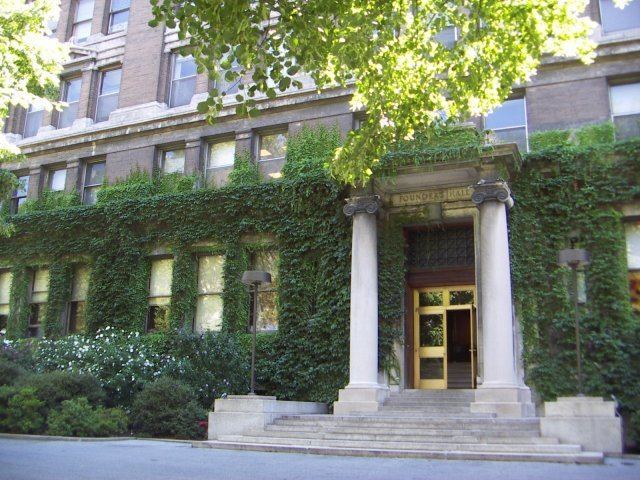Type Private President Richard P. Lifton Total enrollment 195 (2011) Phone +1 212-327-8000 | Established 1901 Endowment 1.987 billion USD Founded 1901 | |
 | ||
Former names The Rockefeller Institute for Medical Research Motto Scientia pro bono humani generis (Latin) Motto in English Science for the benefit of humanity Location New York City (Upper East Side, Manhattan), United States Address 1230 York Ave, New York, NY 10065, USA Founders Frederick Taylor Gates, John D. Rockefeller Notable alumni Robert Sapolsky, David Balti, Barbara Ehrenreich, Harvey Lodish, Seth Lloyd Similar Weill Cornell Graduate, Columbia University, University of California, University of Chicago, Stanford University Profiles | ||
Rockefeller university plans for river campus
The Rockefeller University is a center for scientific research, primarily in the biological and medical sciences, providing doctoral and postdoctoral education. Rockefeller is one of the most prestigious institutes for biomedical research in the world, and it is the oldest such institute in the United States. Of a 78 person faculty (tenured and tenure-track, as of 2016), 38 are members of the National Academy of Sciences, 18 are members of the National Academy of Medicine, 8 are Lasker Award recipients, and 5 are Nobel laureates.
Contents
- Rockefeller university plans for river campus
- History
- Research breakthroughs
- Notable individuals
- At a glance
- Research areas
- University community statistics
- Nobel Prize winners
- Notable alumni
- References
Rockefeller is located on the Upper East Side of Manhattan, between 63rd and 68th Streets along York Avenue.
Richard P. Lifton—previously the executive director of the Center for Human Genetics and Genomics at Yale University—became the university's eleventh president on September 1, 2016.
The Rockefeller University Press publishes the Journal of Experimental Medicine, the Journal of Cell Biology, and The Journal of General Physiology.
History
The Rockefeller University was founded in June 1901 as The Rockefeller Institute for Medical Research—often called simply The Rockefeller Institute—by John D. Rockefeller, who had founded the University of Chicago in 1889, upon advice by his adviser Frederick T. Gates and action taken in March 1901 by his son, John D. Rockefeller Jr. Greatly elevating the prestige of American science and medicine, it was America's first biomedical institute, like France's Pasteur Institute (1888) and Germany's Robert Koch Institute (1891). The Rockefeller Foundation, a philanthropic organization, founded in 1913, is a separate entity, but had close connections mediated by prominent figures holding dual positions.
The first director of laboratories was Simon Flexner, who supervised the development of research capacity at the Institute, whose staff made major discoveries in basic research and medicine. While a student at Johns Hopkins University, Flexner had studied under the Institute's first scientific director, William H. Welch, first dean of Hopkins' medical school and known as the dean of American medicine. Flexner retired in 1935 and was succeeded by Herbert Gasser. He was succeeded in 1953 by Detlev Bronk, who broadened The Rockefeller Institute into a university that began awarding the PhD degree in 1954. In 1965 The Rockefeller Institute's name was changed to The Rockefeller University.
For its first six decades, the Institute focused on basic research to develop basic science, on applied research as biomedical engineering, and, since 1910—when The Rockefeller Hospital opened on its campus as America's first facility for clinical research—on clinical science. The Rockefeller Hospital's first director Rufus Cole retired in 1937 and was succeeded by Thomas Milton Rivers. As director of The Rockefeller Institute's virology laboratory, he established virology as an independent field apart from bacteriology.
Research breakthroughs
Rockefeller has a remarkable history of research breakthroughs especially given the size of the institution. A snippet of the research breakthroughs include:
In the last decade alone, Rockefeller scientists have:
Notable individuals
Notable figures to emerge from the Institution include Alexis Carrel, Peyton Rous, Hideyo Noguchi, Thomas Milton Rivers, Richard Shope, Thomas Francis Jr, Oswald T. Avery, Wendell Meredith Stanley, René Dubos, Ashton Carter, and Cornelius P. Rhoads. Others attained eminence before being drawn to the university. Joshua Lederberg, who won the Nobel Prize in Physiology or Medicine in 1958, served as president of the university from 1978 to 1990. Paul Nurse, who won the Nobel Prize in Physiology or Medicine in 2001, became President in 2003. (Before Nurse's tenure, Thomas Sakmar was acting-president from 2002.) In all, 24 Nobel Prize recipients have been associated with the University. In the mid-1970s, the University attracted a few prominent academicians in the humanities, such as Saul Kripke.
Urged by Rockefeller Jr, his only son, who was enthusiastic about the Institute, Rockefeller Sr visited but once. Rockefeller Jr's youngest son David would visit with his father. David Rockefeller joined the board of trustees in 1940, was its chairman from 1950 to 1975, chaired the board's executive committee from 1975 to 1995, became honorary chairman and life trustee, and remained active as a philanthropist.
At a glance
To foster an interdisciplinary atmosphere among its 79 laboratories, the university assigns a faculty member to one of six interconnecting research areas.
Research areas
University community statistics
Nobel Prize winners
Award affiliations taken from "The Rockefeller University » Nobel Laureates". Retrieved 2016-03-17.
